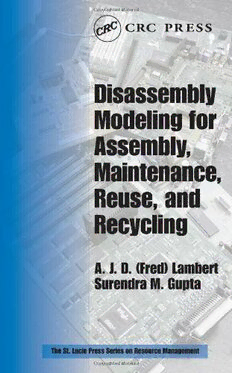Download Disassembly Modeling for Assembly, Maintenance, Reuse and Recycling (Resource Management) PDF Free - Full Version
Download Disassembly Modeling for Assembly, Maintenance, Reuse and Recycling (Resource Management) by A. J. D. Lambert, Surendra M. Gupta in PDF format completely FREE. No registration required, no payment needed. Get instant access to this valuable resource on PDFdrive.to!
About Disassembly Modeling for Assembly, Maintenance, Reuse and Recycling (Resource Management)
Industry has grown to recognize the value of disassembly processes across a wide range of products. Increasing legislation that may soon require mandatory recycling of many post-consumed goods and a desire to develop more environmentally benign end-of-life processes has fueled research into this concept. Traditionally, disassembly has been viewed as the reverse of assembly; however, a novel view considers just the opposite, leading to a more optimized disassembly process.Disassembly Modeling for Assembly, Maintenance, Reuse, and Recycling presents this approach in the context of the entire product life cycle. The book examines disassembly on the intermediate level, incorporating design for disassembly, concurrent design, and reverse logistics. In this first text to supply a comprehensive discussion of the theories and methodologies associated with this approach, the authors incorporate real world case examples to explore the three main areas of application of the theory: assembly optimization, maintenance and repair, and end-of-life processing.This is a timely resource for companies that wish to enact environmentally conscious systems efficiently. With an analysis of associated costs, system design requirements, advantages, and expected results, this is also an indispensable tool for researchers, mechanical and industrial engineers, and professionals involved in concurrent design.
Detailed Information
| Author: | A. J. D. Lambert, Surendra M. Gupta |
|---|---|
| Publication Year: | 2004 |
| ISBN: | 9781574443349 |
| Pages: | 446 |
| Language: | English |
| File Size: | 5.986 |
| Format: | |
| Price: | FREE |
Safe & Secure Download - No registration required
Why Choose PDFdrive for Your Free Disassembly Modeling for Assembly, Maintenance, Reuse and Recycling (Resource Management) Download?
- 100% Free: No hidden fees or subscriptions required for one book every day.
- No Registration: Immediate access is available without creating accounts for one book every day.
- Safe and Secure: Clean downloads without malware or viruses
- Multiple Formats: PDF, MOBI, Mpub,... optimized for all devices
- Educational Resource: Supporting knowledge sharing and learning
Frequently Asked Questions
Is it really free to download Disassembly Modeling for Assembly, Maintenance, Reuse and Recycling (Resource Management) PDF?
Yes, on https://PDFdrive.to you can download Disassembly Modeling for Assembly, Maintenance, Reuse and Recycling (Resource Management) by A. J. D. Lambert, Surendra M. Gupta completely free. We don't require any payment, subscription, or registration to access this PDF file. For 3 books every day.
How can I read Disassembly Modeling for Assembly, Maintenance, Reuse and Recycling (Resource Management) on my mobile device?
After downloading Disassembly Modeling for Assembly, Maintenance, Reuse and Recycling (Resource Management) PDF, you can open it with any PDF reader app on your phone or tablet. We recommend using Adobe Acrobat Reader, Apple Books, or Google Play Books for the best reading experience.
Is this the full version of Disassembly Modeling for Assembly, Maintenance, Reuse and Recycling (Resource Management)?
Yes, this is the complete PDF version of Disassembly Modeling for Assembly, Maintenance, Reuse and Recycling (Resource Management) by A. J. D. Lambert, Surendra M. Gupta. You will be able to read the entire content as in the printed version without missing any pages.
Is it legal to download Disassembly Modeling for Assembly, Maintenance, Reuse and Recycling (Resource Management) PDF for free?
https://PDFdrive.to provides links to free educational resources available online. We do not store any files on our servers. Please be aware of copyright laws in your country before downloading.
The materials shared are intended for research, educational, and personal use in accordance with fair use principles.

